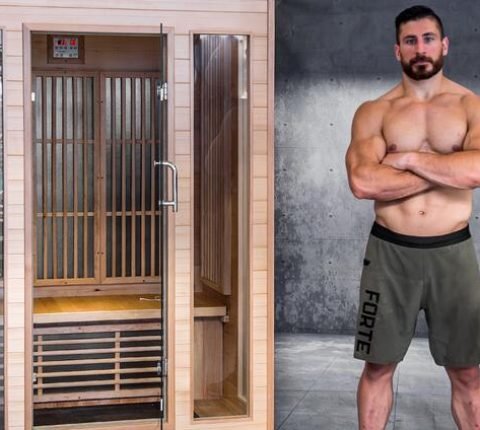You know what they say…’Win the morning, win the day’!
Let’s be honest, mornings can be hard! It’s not uncommon to have to drag yourself out of your warm, comfortable bed, stumble bleary eyed through to the kitchen, struggling to function as you desperately brew the first cup of coffee for the day to get you kick started….sound familiar?
On the other hand, you might be one of those lucky morning people who bounce out of bed at the slightest sign of daylight, invigorated and ready for the day.
However, whether you’re a morning person or not starting your day with these 5 simple bodyweight exercises can kick start your day for a great day, every day. These exercises don’t require any equipment, take up minimal space and can be done from the comfort of your very own home.
Though exercise is no doubt a crucial part of building a strong, fit and resilient body, it’s no use if we don’t recover from it. Sleep, nutrition, hydration and movement that facilitates blood flow all play a crucial role in encouraging recovery and there is no better way to start the process than by following up your fitness routine with some time in the sauna.
Exposing our bodies to heat, such as in a sauna, causes very specific proteins in the body to be activated known as heat shock proteins. These proteins have been studied and proven to be extremely effective at promoting recovery in muscle tissue – helping us speed up the recovery process and get the most out of each training session, allowing us to come back fitter and stronger every time.
The Moves

Move 1: The Squat
The squat is a staple in any good exercise program and for good reason. The perfect movement to build strength, stability, mobility and athleticism in the lower body, the squat focuses primarily on the muscles of the glutes (your butt cheeks), quadriceps (the front of your thighs) and hamstrings (back of your thighs) but also incorporates some great midline stability to help build a strong and robust core.
Set-Up:
- Feet between hip and shoulder width
- Toes angled out just slightly – think 11 & 1 on a clock face
- Core tight – abs and butt engaged
- Hands for balance
Execution:
- Begin the movement by pushing your hips and butt back and transferring the weight to your heels
- Begin the descent by bending at the knee while keeping the weight back in your heels and your torso as upright as possible
- As you descend make sure to keep your knees tracking over your toes and don’t let them collapse inside – this is key for keeping your knees healthy and injury free
- While making sure your entire foot stays in contact with the ground and without drifting into your toes, keep descending until the crease of your hip breaks parallel before reversing the movement and returning to standing.

Move 2: The Push-Up
An upper body staple, the push up builds strength across much of the torso and upper body including the chest, shoulders and triceps. Though this exercise has been around since the beginning of time, and may seem straightforward on paper, there are still a few key points we need to keep in mind for safe and effective execution.
Set-up:
- Feet hip width apart
- Hands slightly wider than shoulder width and directly under the shoulders
- Neutral spine and a tight, engaged midline – we don’t want any bowing or sagging of our hips.
Execution:
- From the start position begin the push up by slightly leaning forward as you begin to bend the elbow
- Keep your arms tucked close to your sides as you descend – we don’t want them flaring out at 90 degrees as this puts the shoulder in a more vulnerable position
- Keeping your core tight and spine neutral, keep descending until your chest touches the floor – yes, this is a full range of motion push-up, no stopping half way down here!
- When you reach the bottom position your elbows should be stacked directly over your wrists, from here begin to press back to the top, making sure your hips and shoulders both rise at the same rate.
Scaling the Push-Up:
- Though the push-up might seem basic that doesn’t make it easy by any means. A proper, full range of motion push up requires a good amount of upper body strength and might not be achievable straight off the bat. To scale the push up you have a couple of options, 1) perform the exact same movement but with your knees on the floor – this makes the push-up easier by decreasing the amount of bodyweight we are pressing and slightly changing the angle of the press itself. 2) perform the push-up with your hands on an elevated surface higher than your feet. By changing the angle of the body we can manipulate the difficulty of the push-up. The higher your hands the easier it will be and vice versa.

Move 3: Side Plank Rotations
A fantastic variation of a regular side plank, the side plank rotation challenges the core and midline while also working the muscles of the mid back and shoulders. By adding rotation we are helping keep our shoulders healthy and balancing the body from front to back with any pressing movements we might do.
Set-Up:
- Resting your bodyweight on one elbow and the same side foot keep your midline and abs engaged, keeping a straight line from your heels, through your hips and to your shoulder.
- Spread the fingers of the hand on the floor as wide as possible in order to create as big a base of support as possible and help provide stability and balance.
Execution:
- From here, reach your opposite arm under your body and as far round as possible while staying under control.
- This is going to force you to rotate around the shoulder joint but be sure not to go too far – only take it as far as you can maintain full control and balance.
- From here reverse the rotation until you are back to the starting point and really focus on squeezing your shoulder blades together

Move 4: V-Ups
No workout routine would be complete without incorporating some focused and direct work for the core and abs. Having a strong core and great abs is about far more than just how they look but how your body functions as a whole during athletic endeavours. Your core and midline is the base of stability for the rest of your body to work from not to mention strengthening your core will also decrease your risk of back pain and issues.
Set-Up:
- Lying flat on the ground, squeeze your ribs down to raise your shoulders off the floor and raise your feet slightly so that your entire low back is in contact with the ground. This position of base tension is your starting point.
Execution:
- From this position hinge at the hip by flexing your abs and hip flexors, raising your feet and reaching with your arms. The goal is to try and touch your hands to your toes or at least as far down your leg as possible.
- From there return back to your base tension under control and repeat. For the most effective ab workout try not to let your hands or feet touch the floor for the entire set.

Move 5: The Burpee
For capping off the routine there couldn’t be a better choice then this full body move that gets your heart rate up and builds strength and athleticism from head to toe. Love it or hate it, the burpee is the king of bodyweight conditioning exercises.
Set-Up:
- Nice and simple – start standing tall and get ready for some real work!
Execution:
- From standing lower your hands to the ground while jumping your feet out behind you
- From here lower yourself to the floor until your chest and thighs make contact with the ground
- As you push back to the top snap your hips into the air as you bring your feet back under you to land in a quarter squat
- Finish the move by jumping high and clapping your hands overhead
Now that we know the moves and we have the technique for each move it’s time to put them into practice. Here are 3 options for beginners to advance to get your morning off to a flying start!
WORKOUT SEQUENCES
Great! Now that you’ve got the moves down, it’s time to put it together. Put on our favourite exercise playlist and give these sequences a go. Let us know how you get on!
Option 1 – Beginner
3 rounds for quality and minimum rest:
- 5 Push Ups OR Push Ups off knees
- 10 Squats
- 5 Side Plank Rotations/side
- 10 V-Ups
- 30 seconds of Burpees
Rest 1:00 between rounds.
Option 2 – Intermediate
5 rounds for time:
- 21 Squats
- 15 Push Ups
- 9 V-Ups
- 6 Side Plank Rotations/side
- 12 Burpees
Option 3 – Advance
In 15 minutes climb as high up the ladder as possible:
- Rd 1 – 1 Push up, 1 squat, 1 V-Up, 1 Side plank rotation per side, 1 Burpee
- Rd 2 – 2 Push ups, 2 squats, 2 V-Ups, 2 Side plank rotations per side, 2 Burpees
- Rd 3 – 3 Push ups, 3 squats, 3 V-Ups, 3 Side plank rotations per side, 3 Burpees
Keep adding one more of the move per set as you climb the ladder – see how high you can go within the 15 minutes!





 Health & Habits
Health & Habits  Health & Habits
Health & Habits  Health & Habits
Health & Habits